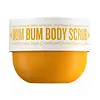What's inside
What's inside
 Key Ingredients
Key Ingredients

 Benefits
Benefits

 Concerns
Concerns

 Ingredients Side-by-side
Ingredients Side-by-side

Sucrose
HumectantCocos Nucifera Oil
MaskingSodium Chloride
MaskingCetearyl Olivate
Sorbitan Olivate
EmulsifyingOlus Oil
EmollientParfum
MaskingSilica
AbrasiveEuterpe Oleracea Fruit Oil
Skin ConditioningTheobroma Grandiflorum Seed Powder
AbrasiveTheobroma Grandiflorum Seed Butter
Skin ConditioningPaullinia Cupana Seed Extract
Skin ConditioningRosmarinus Officinalis Leaf Extract
AntimicrobialTocopherol
AntioxidantHelianthus Annuus Seed Oil
EmollientGlycerin
HumectantWater
Skin ConditioningOryza Sativa Bran Extract
Skin ConditioningGlyceryl Caprylate
EmollientCaprylhydroxamic Acid
Phenoxyethanol
PreservativeSynthetic Fluorphlogopite
Tin Oxide
AbrasiveBenzyl Alcohol
PerfumingBenzyl Salicylate
PerfumingCoumarin
PerfumingLimonene
PerfumingCI 77891
Cosmetic ColorantSucrose, Cocos Nucifera Oil, Sodium Chloride, Cetearyl Olivate, Sorbitan Olivate, Olus Oil, Parfum, Silica, Euterpe Oleracea Fruit Oil, Theobroma Grandiflorum Seed Powder, Theobroma Grandiflorum Seed Butter, Paullinia Cupana Seed Extract, Rosmarinus Officinalis Leaf Extract, Tocopherol, Helianthus Annuus Seed Oil, Glycerin, Water, Oryza Sativa Bran Extract, Glyceryl Caprylate, Caprylhydroxamic Acid, Phenoxyethanol, Synthetic Fluorphlogopite, Tin Oxide, Benzyl Alcohol, Benzyl Salicylate, Coumarin, Limonene, CI 77891
Pumice
AbrasiveWater
Skin ConditioningGlycolic Acid
BufferingSodium Cocoyl Isethionate
CleansingLactic Acid
BufferingDimethicone
EmollientStearic Acid
CleansingCetearyl Alcohol
EmollientSodium Hydroxide
BufferingPalmitic Acid
EmollientGlycerin
HumectantC12-15 Alkyl Benzoate
AntimicrobialSorbitol
HumectantColloidal Oatmeal
AbsorbentTocopherol
AntioxidantChrysanthemum Parthenium Extract
Skin ConditioningCamellia Sinensis Leaf Extract
AntimicrobialGlycyrrhiza Glabra Root Extract
BleachingSalix Nigra Bark Extract
Skin ProtectingBisabolol
MaskingHydrogenated Coconut Acid
EmollientXanthan Gum
EmulsifyingSteareth-20
CleansingSteareth-21
CleansingMyristic Acid
CleansingSodium Isethionate
CleansingPhenoxyethanol
PreservativePotassium Sorbate
PreservativeSodium Benzoate
MaskingLeuconostoc/Radish Root Ferment Filtrate
AntimicrobialEDTA
Pumice, Water, Glycolic Acid, Sodium Cocoyl Isethionate, Lactic Acid, Dimethicone, Stearic Acid, Cetearyl Alcohol, Sodium Hydroxide, Palmitic Acid, Glycerin, C12-15 Alkyl Benzoate, Sorbitol, Colloidal Oatmeal, Tocopherol, Chrysanthemum Parthenium Extract, Camellia Sinensis Leaf Extract, Glycyrrhiza Glabra Root Extract, Salix Nigra Bark Extract, Bisabolol, Hydrogenated Coconut Acid, Xanthan Gum, Steareth-20, Steareth-21, Myristic Acid, Sodium Isethionate, Phenoxyethanol, Potassium Sorbate, Sodium Benzoate, Leuconostoc/Radish Root Ferment Filtrate, EDTA
 Reviews
Reviews

Ingredients Explained
These ingredients are found in both products.
Ingredients higher up in an ingredient list are typically present in a larger amount.
Glycerin is already naturally found in your skin. It helps moisturize and protect your skin.
A study from 2016 found glycerin to be more effective as a humectant than AHAs and hyaluronic acid.
As a humectant, it helps the skin stay hydrated by pulling moisture to your skin. The low molecular weight of glycerin allows it to pull moisture into the deeper layers of your skin.
Hydrated skin improves your skin barrier; Your skin barrier helps protect against irritants and bacteria.
Glycerin has also been found to have antimicrobial and antiviral properties. Due to these properties, glycerin is often used in wound and burn treatments.
In cosmetics, glycerin is usually derived from plants such as soybean or palm. However, it can also be sourced from animals, such as tallow or animal fat.
This ingredient is organic, colorless, odorless, and non-toxic.
Glycerin is the name for this ingredient in American English. British English uses Glycerol/Glycerine.
Learn more about GlycerinPhenoxyethanol is a preservative that has germicide, antimicrobial, and aromatic properties. Studies show that phenoxyethanol can prevent microbial growth. By itself, it has a scent that is similar to that of a rose.
It's often used in formulations along with Caprylyl Glycol to preserve the shelf life of products.
Tocopherol (also known as Vitamin E) is a common antioxidant used to help protect the skin from free-radicals and strengthen the skin barrier. It's also fat soluble - this means our skin is great at absorbing it.
Vitamin E also helps keep your natural skin lipids healthy. Your lipid skin barrier naturally consists of lipids, ceramides, and fatty acids. Vitamin E offers extra protection for your skin’s lipid barrier, keeping your skin healthy and nourished.
Another benefit is a bit of UV protection. Vitamin E helps reduce the damage caused by UVB rays. (It should not replace your sunscreen). Combining it with Vitamin C can decrease sunburned cells and hyperpigmentation after UV exposure.
You might have noticed Vitamin E + C often paired together. This is because it is great at stabilizing Vitamin C. Using the two together helps increase the effectiveness of both ingredients.
There are often claims that Vitamin E can reduce/prevent scarring, but these claims haven't been confirmed by scientific research.
Learn more about TocopherolWater. It's the most common cosmetic ingredient of all. You'll usually see it at the top of ingredient lists, meaning that it makes up the largest part of the product.
So why is it so popular? Water most often acts as a solvent - this means that it helps dissolve other ingredients into the formulation.
You'll also recognize water as that liquid we all need to stay alive. If you see this, drink a glass of water. Stay hydrated!
Learn more about Water